<Back to Index>
- Anatomist Regnier de Graaf, 1641
- Author Emily Jane Brontë, 1818
- Member of the Reichstag Eugen Richter, 1838
PAGE SPONSOR


Emily Jane Brontë (30 July 1818 – 19 December 1848) was an English novelist and poet, now best remembered for her novel Wuthering Heights, a classic of English literature. Emily was the second eldest of the three surviving Brontë sisters, between Charlotte and Anne. She published under the androgynous pen name Ellis Bell.
Emily Brontë was born in Thornton, near Bradford in Yorkshire, to Maria Branwell and Patrick Brontë. She was the younger sister of Charlotte Brontë and the fifth of six children. In 1824, the family moved to Haworth, where Emily's father was perpetual curate, and it was in these surroundings that their literary gifts flourished. After
the death of their mother, the older sisters Maria, Elizabeth and
Charlotte were sent to the Clergy Daughters' School at Cowan Bridge,
where they encountered abuse and privations later described by
Charlotte in Jane Eyre. Emily joined the school for a brief period. When a typhus epidemic swept the school Maria and Elizabeth caught it. Maria, who may actually have had tuberculosis,
was sent home, where she died. Emily was subsequently removed from the
school along with Charlotte and Elizabeth. Elizabeth died soon after
their return home. The three remaining sisters and their brother Patrick Branwell Brontë were
thereafter homeschooled by their father and aunt Elizabeth Branwell,
their mother's sister. In their leisure time the children created a
number of paracosms, which were featured in stories they wrote and enacted about the imaginary adventures of their toy soldiers along with the Duke of Wellington and
his sons, Charles and Arthur Wellesley. Little of Emily's work from
this period survived, except for poems spoken by characters. At
thirteen, Emily and Anne withdrew from participation in the Angria
story and began a new one about Gondal, a large island in the North
Pacific. If they wrote stories or novels about Gondal, these were not
preserved. Some "diary papers" of Emily's have survived in which she
describes current events in Gondal, some of which were written, others
enacted with Anne. One dates from 1841, when Emily was twenty-three: another from 1845, when she was twenty-seven. Anne made a list of Gondal names and places which also survives. At
seventeen, Emily attended the Roe Head girls' school, where Charlotte
was a teacher, but managed to stay only three months before being overcome by extreme homesickness. She returned home and Anne took her place. At this time, the girls' objective was to obtain sufficient education to open a small school of their own. Emily became a teacher at Law Hill School in Halifax beginning
in September 1838, when she was twenty. Her health broke under the
stress of the 17-hour work day and she returned home in April 1839.
Thereafter she became the stay-at-home daughter, doing most of the
cooking and cleaning and teaching Sunday school. She taught herself
German out of books and practiced piano. In 1842, Emily accompanied Charlotte to Brussels, Belgium, where they attended a girls' academy run by Constantin Heger.
They planned to perfect their French and German in anticipation of
opening their school. Nine of Emily's French essays survive from this
period. The sisters returned home upon the death of their aunt. They
did try to open a school at their home, but were unable to attract
students to the remote area. In
1844, Emily began going through all the poems she had written,
recopying them neatly into two notebooks. One was labeled "Gondal
Poems", the other was unlabeled. Scholars such as Fannie Ratchford and
Derek Roper have attempted to piece together a Gondal storyline and
chronology from these poems.
In
the fall of 1845, Charlotte discovered the notebooks and insisted that
the poems be published. Emily, furious at the invasion of her privacy,
at first refused, but relented when Anne brought out her own
manuscripts and revealed she had been writing poems in secret as well.
In 1846, the sisters' poems were published in one volume as Poems by Currer, Ellis, and Acton Bell.
To evade contemporary prejudice against female writers, the Brontë
sisters had adopted androgynous first names. Emily used the name "Ellis
Bell". The poetry received mediocre reviews. In the meantime they had
begun work on their first professional novels. In 1847, Emily published her only novel, Wuthering Heights, as two volumes of a three-volume set (the last volume being Agnes Grey by
her sister Anne). Its innovative structure somewhat puzzled critics.
Although it received mixed reviews when it first came out, and was
often condemned for its portrayal of amoral passion, the book
subsequently became an English literary classic. In 1850, Charlotte
edited and published Wuthering Heights as a stand-alone novel and under Emily's real name. Emily's
health, like her sisters', had been weakened by unsanitary conditions
at home, the source of water being contaminated by runoff from the
church's graveyard. She caught a cold during the funeral of her brother
in September 1848. Refusing medical help, she died on 19 December 1848
at about two in the afternoon. She was interred in the Church of St. Michael and All Angels family capsule, Haworth, West Yorkshire.